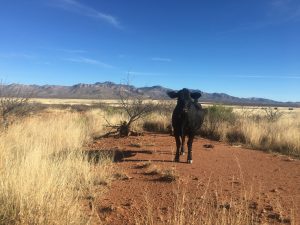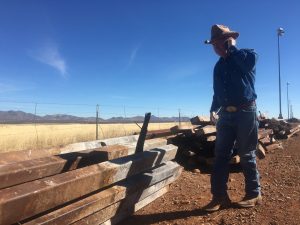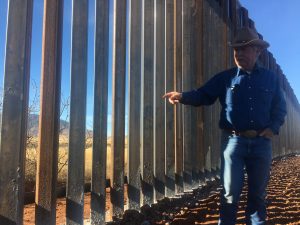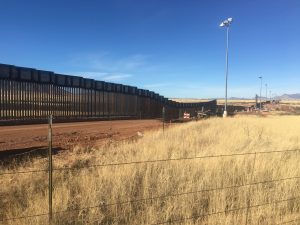- Slug: BC-CNS-Border Wall,950
- Photos (thumbnails, captions below)
By GARRISON MURPHY
Cronkite News
DOUGLAS – John Ladd stepped out of his rusted, red pickup truck to lead a herd of cattle through a gate on his 16,000-acre ranch which borders border, chain and padlock swinging from his hand.
“There’s an open gate right there; that’s what I was talking about,” Ladd said. “Border Patrol doesn’t like closing gates.”
The gate Ladd referred to is designed to keep cattle separated. Leaving a gate open can have dire consequences for a rancher. The gate also borders a ravine he said is commonly used by undocumented immigrants and smugglers who cross through his ranch.
“It used to take five days to get the ranch rounded up; it takes me seven weeks now and it’s because anybody coming through illegally cuts through fences and border patrol doesn’t know how to shut a gate,” Ladd said.
Both Border Patrol and Ladd have keys to locks on his gates, but he said agents often leave the gates open. Despite Ladd’s disagreements with Border Patrol, he supports President Donald Trump’s executive order to build a wall and authorize Border Patrol to hire 5,000 more agents.
“It used to be a lot of immigrants coming over and now it’s mostly drug mules they catch here,” Ladd said. “They just go right over (the fence).” Ladd said he and agents have found 14 bodies on his ranch since the Border Patrol started patrolling back in the 1980s.
He said people who cross the border illegally cut through his land daily to reach Highway 92.
Ladd said although his relationship is better than that it has been in past, he still have disagreements over how the agents do their jobs.
“They’ve torn up my property more than the illegals,” said Ladd. “They have no respect for land and they have no respect for landowners … I was here first.”
Ladd said the quick turnover rate of agents puts a strain on his relationship with Border Patrol because he has to get to know new agents and teach them about ranch life.
He also said his biggest frustration is with Congress “not allowing Border Patrol to do their job” and that he hopes this new executive order will change that. He supports locking up illegal border crossers rather than sending them back to Mexico.
Ladd’s family has owned the ranch since 1896. He said before the 1980s he rarely had issues with people crossing the border illegally. In the past he helped immigrants who worked his land, including Mexican cowboys become U.S. citizens.
However, others living near the border don’t share the the ranchers concerns.
“It reminds me of buying a house next to an airport and complaining about the noise,” said Ronald Oertle, mayor of neighboring Bisbee.
Tom Wheeler, a former Bisbee mayor and resident for 35 years said most immigrants crossing the border are not malicious and that it is an issue that is oversold by politicians and border ranchers.
“The immigration problem is a big smoke screen, most of the people coming here overstay their visa or green card,” Wheeler said. “Most of the people coming across here are coming from Central America and it’s all poverty.”
Fred Davis, a rancher whose property is 17 miles north of the the border, said he has encountered problems with border crossers on his land. He said townspeople don’t understand the difficulties he faces.
“You go into Sierra Vista and ask them how many problems we have and they won’t have a clue, they will say they have no problems,” Davis said. “It’s all relative till it’s your relative.”
He said although he has not had as many encounters with Border Patrol agents, he is still critical of their strategies and that “John Ladd’s ranch is the greatest example of the Border Patrol failure.”
The death of fellow rancher in 2010 changed how Davis and Ladd they feel about dealing with migrants.
Robert Krentz and his dog were shot and killed on his ranch while checking on someone who appeared to be injured. Investigators found footprints leading to Mexico but have not arrested any suspects for the crime.
“Sure, it is frightening,” Davis said. “He was a good friend of mine since high school … Rob was a very careful man and a very compassionate guy.”
Since Krentz’s death Davis said he is “not going to get in gunshot range of any (border crossers).”
Ladd, bought his first cell phone after Krentz’s death.
“That’s how it is down here, if you leave your house for a day you’re going to get robbed,” Ladd said. “They’ve been in my house, they steal trucks, steal tools. It was a daily event. We still can’t leave without somebody being here.”
Ladd and Davis said they have had multiple break-ins on their ranches. Ladd said Border Patrol catches about 30-50 people a week on his property, which is a sharp decline from a decade ago when they apprehended approximately 200 border crossers a week.
“I’m sure there are some (border crossers) here right now” Ladd said. “They’re watching me all the time.”
^__=




